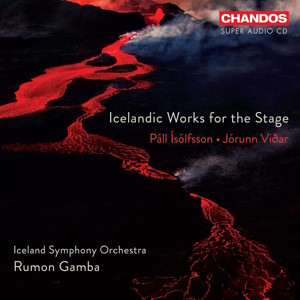
Icelandic Works for the Stage
Jórunn Viðar (1918-2017)
Eldur (1950)
Ólafur Liljurós (1952)
Páll Ísólfsson (1893-1974)
Veislan á Sólhaugum (1943)
Úr Myndabók Jónasar Hallgrímssonar (1945)
Iceland Symphony Orchestra/Rumon Gamba
rec. 2022, Eldborg, Harpa, Reykjavik, Iceland
Chandos CHSA5319 SACD [64]
It can be difficult listening to incidental music for stage works which you haven’t seen; the same applies to filmscores of unwatched movies. If approached as abstract music, they can often seem to be comprised of random, generally brief, pieces without any obvious connection or reason. Having visited Iceland recently, and knowing so little about its music, this new release intrigued me more so than an equivalent release from elsewhere. I did some sample listening, which was encouraging – you may interpret that as meaning “tonal” and “melodic” – and offered my reviewing services.
Being a classical composer in Iceland was not really an occupation until quite recently. There was no orchestra in the country until 1921, and no conservatory until 1930. Anyone wishing to learn and to make a living needed to do so overseas. Páll Ísólfsson and his better-known compatriot Jón Leifs did just that, both studying in Leipzig. Ísólfsson came back in 1930 to be director of the Reykjavik Music School.It was there thanJórunn Viðar undertook her training (before time in Berlin and at the Juilliard).
The two pieces by Viðar were written for ballets, in collaboration with Sigriður Ármann: the two met in New York. Eldur (Fire) was the first ballet performed at the new National Theatre in Reykjavik. It comprises a single movement of almost ten minutes, which moves through a range of musical ideas, loud and fast, soft and slow, which are intended to portray the various moods of fire. How effectively it does this is possibly more a matter of the choreography that it accompanied, but as simply music, it is impressive and enjoyable. It is also not of its time, being full of melody. In terms of imagery, I could see it equally at home as the score for a Hollywood adventure film.
Ólafur Liljurós is a narrative ballet, based on a rather grim Nordic ballad, where the eponymous hero encounters elf-maidens who want him to live with them. When he refuses, one kills him with a sword (I said it was grim). The twenty-eight minutes of music are divided into eight sections, and are obviously more episodic, and less satisfying for normal listening. By the time you absorb the musical ideas, they are over. The writing, nevertheless, remains impressive – Sibelius, Vaughan Williams and further afield, Douglas Lilburn come to mind – and I’d love to hear some of Viðar’s other orchestral works.
Páll Ísólfsson’s music is very evidently of an earlier generation, though especially Germanic despite his musical education. Veislan á Sólhaugum was incidental music for an early Ibsen play, set in medieval times. The rustic nature of the music reflects that. Úr Myndabók Jónasar Hallgrímssonar (From Jónas Halgrimsson’s Picture Book) was written as part of the celebration of the 100th anniversary of the death of the prominent Icelandic poet of the nineteenth century. The performance in 1945 was also a celebration of Icelandic independence from Denmark the year before, though it must be said that most of the music is relatively restrained. Three of the short movements are based on Icelandic folk tunes. Perhaps not surprisingly, the musical style brings Grieg to mind and also two Norwegian Johans, Halvorsen and Svendsen, previously championed by Chandos. Ísólfsson is of a later generation, but in these two works, he is writing music intended to reflect earlier times. However, I believe this to be his style. There is a much earlier Chandos recording (CHAN9180) of Icelandic orchestral music, which includes two festive works by Ísólfsson, the march written for the opening of the National Theatre. Again, the style is much earlier than mid-20th century, and there are definite Brahmsian touches as well, undoubtedly from the time Ísólfsson spent in Leipzig.
I first became aware of the Iceland Symphony Orchestra with their wonderful d’Indy series for Chandos, also under the baton of Rumon Gamba. I would have loved to have heard them play in the glorious Harpa concert hall in Reykjavik when I was there, but alas it was not to be. The recording here exhibits the usual rich Chandos sound. It is a SACD, but I could only listen in stereo.
The notes provided by Chandos are usually exemplary, so I was rather surprised to find that the biographies of both composers end at the compositions on this recording. I presume each had some sort of career afterwards: Ísólfsson lived for another twenty-nine years after Úr Myndabók and Viðar for sixty-five after Ólafur Liljurós. The background to each work and a guide to the music is excellent, so the absence of information on the remainder of their lives is disappointing.
None of the music here is a lost masterpiece, but it is all very well crafted to support the action on stage of the actors and dancers and thoroughly enjoyable. Jórunn Viðar, in particular, strikes me as a composer whose other works should be on the to-do list for the ISO, Gamba and Chandos.
David Barker
Help us financially by purchasing from




















